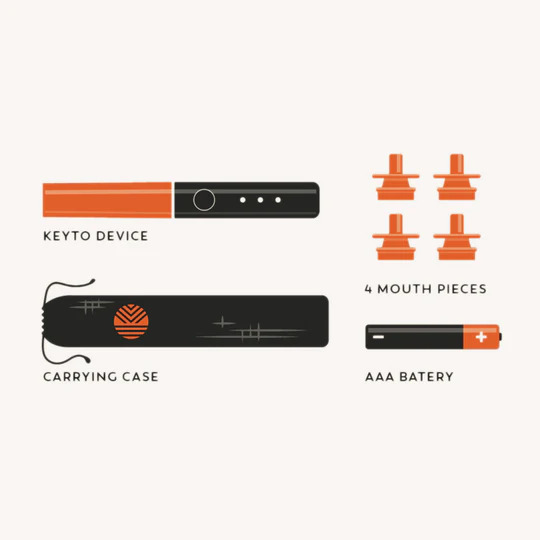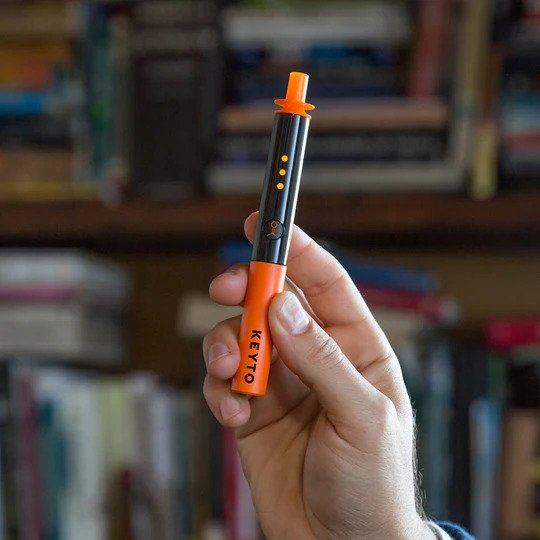Introduction to Keyto Breath Sensor
Unlocking the Power of Breath: Introducing the Keyto Breath Sensor The Keyto Breath Sensor is a revolutionary device that has taken the world of health and wellness by storm.
This cutting-edge technology allows individuals to track their breath acetone levels, providing valuable insights into their metabolic state and facilitating effective weight loss strategies. With its sleek design and user-friendly interface, the Keyto Breath Sensor has become an indispensable tool for those embarking on a ketogenic lifestyle or seeking to optimize their metabolic health.
Definition and Purpose of the Keyto Breath Sensor
At its core, the Keyto Breath Sensor is a breath analyzer specifically designed to measure acetone levels in one’s breath. Acetone is a metabolite produced during ketosis, a metabolic state where the body predominantly burns fat for fuel rather than carbohydrates. By measuring breath acetone levels with precision, this sensor offers individuals an accurate indication of their level of ketosis.
The primary purpose of the Keyto Breath Sensor is to provide users with real-time feedback on their metabolic state, allowing them to fine-tune their dietary choices and optimize their weight loss journey. It serves as a reliable companion for individuals following low-carbohydrate diets such as the ketogenic diet or those looking to understand how certain foods affect their ability to enter or sustain ketosis.
Importance of tracking and understanding breath acetone levels
Tracking breath acetone levels holds immense significance in achieving weight loss goals and maintaining optimal metabolic health. Acetone serves as an essential biomarker for ketosis, reflecting the utilization of stored body fat as an energy source. By monitoring these levels, individuals can gauge whether they are efficiently burning fat or if adjustments in diet or lifestyle are required.
Understanding one’s breath acetone levels also aids in avoiding pitfalls that may hinder progress. The ability to identify food triggers that negatively impact ketosis empowers individuals to make informed choices, steering clear of hidden carbohydrates or other factors that might unknowingly impede their weight loss efforts.
Overview of how the Keyto Breath Sensor works
The Keyto Breath Sensor operates on a simple yet sophisticated principle. When users exhale into the device, it captures and analyzes the concentration of acetone in their breath through gas chromatography technology. This highly accurate method offers individuals real-time feedback on their current level of ketosis.
The sensor seamlessly integrates with advanced algorithms, which interpret the acetone readings and provide personalized insights based on an individual’s metabolic data. These insights can include recommendations for dietary adjustments, progress tracking toward weight loss goals, and even identifying specific foods that may be hindering ketosis.
The Keyto Breath Sensor is a game-changer in the realm of metabolic health monitoring and weight loss management. By accurately measuring breath acetone levels, this innovative device empowers individuals to make informed decisions about their dietary choices and optimize their journey toward improved health and well-being.
Understanding Acetone and Ketosis
The Metabolic Wonder: Ketosis
Ketosis, a metabolic state often associated with low-carbohydrate diets such as the ketogenic diet, has gained significant attention in recent years for its potential benefits in weight loss and overall metabolic health. When the body’s carbohydrate intake is limited, it adapts by breaking down stored fats into ketones to provide energy.
These ketones, particularly beta-hydroxybutyrate (BHB), become the primary fuel source for various bodily functions. This shift from carbohydrates to fats as the main energy source is what characterizes ketosis.
Acetone: The Silent Byproduct
During this fat-burning process, an intriguing byproduct called acetone is produced alongside BHB. Acetone belongs to a class of compounds known as ketones and is generated when stored fat undergoes metabolism.
Unlike BHB, which provides energy and serves various physiological functions, acetone does not possess any significant metabolic role. Instead, it is primarily eliminated from the body through breath and urine.
The Significance of Measuring Breath Acetone Levels
As acetone is released through exhalation during ketosis, its measurement serves as an effective proxy for monitoring the body’s state of ketosis non-invasively. Traditionally, blood and urine tests were used to assess levels of ketones; however, these methods can be inconvenient and time-consuming for frequent monitoring. The advent of cutting-edge technology like the Keyto Breath Sensor offers a more accessible means to track breath acetone levels accurately.
Tracking breath acetone offers several advantages over other measurement methods. First, it enables real-time insights into one’s current state of ketosis without requiring blood pricks or collecting urine samples at specific intervals.
Moreover, breath analysis eliminates the need for expensive testing supplies and can be conducted discreetly in any setting. By simply exhaling into the Keyto Breath Sensor, users can obtain immediate feedback on their breath acetone levels, empowering them to make informed decisions about their dietary choices and ensure they remain in ketosis.
Unlocking the Potential: Personalized Ketosis Monitoring
Monitoring breath acetone levels not only helps verify if an individual is in ketosis but also offers personalized insights based on individual data. By tracking changes in breath acetone concentrations over time, users gain a better understanding of their body’s response to different foods, exercise regimens, and lifestyle modifications.
This information can aid in identifying specific triggers that may hinder or enhance ketosis progress. Armed with these insights, individuals can make targeted adjustments to their diet and lifestyle for optimal results.
Understanding the relationship between acetone and ketosis is crucial for appreciating the significance of measuring breath acetone levels with devices like the Keyto Breath Sensor. Ketosis represents a metabolic state where fats are used as the primary fuel source instead of carbohydrates.
Acetone is a byproduct of fat metabolism during ketosis and is expelled through breath analysis, offering a non-invasive method for monitoring one’s state of ketosis. This innovative technology allows individuals to gain real-time insights into their breath acetone levels conveniently and provides personalized guidance towards achieving and maintaining optimal health through ketogenic lifestyles.
A detailed explanation of the technology used in the sensor
The Breathalyzer Concept
The Keyto Breath Sensor, also known as a breath analyzer or breathalyzer, is a remarkable device that utilizes cutting-edge technology to provide precise measurements of breath acetone levels. Acetone is one of the ketones produced when the body is in a state of ketosis, making it an essential biomarker for monitoring metabolic health and weight loss progress. The sensor comprises various components that work together harmoniously to deliver accurate readings.
Gas Chromatography Principles for Accuracy
At the heart of the Keyto Breath Sensor lies a sophisticated gas chromatography system. Gas chromatography is an analytical technique widely used in scientific research and medical diagnostics due to its exceptional accuracy and reliability.
The principle behind this method involves separating and analyzing volatile compounds present in a gas sample. In the context of breath analysis, gas chromatography detects and quantifies acetone molecules present in exhaled breath.
Integration with Advanced Algorithms for Precision
To ensure precise readings, the Keyto Breath Sensor integrates advanced algorithms that process data obtained from gas chromatography. These algorithms take into account various factors such as temperature, humidity, pressure, and other potential interference sources to deliver accurate acetone concentration results. By continuously improving these algorithms through machine learning techniques, Keyto ensures that users can rely on consistent and trustworthy data provided by their Breath Sensor.
Non-invasive Nature Compared to Blood or Urine Testing
One significant advantage of using the Keyto Breath Sensor over traditional blood or urine testing methods is its non-invasive nature. While blood sampling requires needle pricks and urine testing necessitates collection cups or strips, breath analysis with Keyto’s innovative sensor simply involves exhaling into it.
This non-invasive approach eliminates any discomfort associated with invasive sampling techniques and provides a hassle-free user experience. Moreover, the non-invasive nature of breath analysis simplifies continuous monitoring, allowing users to track their ketosis levels conveniently throughout the day.
Enhancing User Experience and Compliance
The Keyto Breath Sensor is designed with user experience and compliance in mind. By offering a non-intimidating and easy-to-use device, Keyto encourages consistent usage. Additionally, unlike blood or urine testing, which require specialized equipment or disposal methods, the Keyto Breath Sensor offers a portable and discreet solution that can be carried anywhere.
This convenience ensures that individuals can monitor their ketosis levels regularly without disruption to their daily routines. By employing gas chromatography principles for accurate measurements, integrating advanced algorithms for precision analysis, and adopting a non-invasive approach compared to blood or urine testing methods, the Keyto Breath Sensor stands out as an innovative tool for tracking breath acetone levels efficiently and effectively.
Its technology represents a significant leap forward in the field of metabolic health monitoring, empowering individuals on their journey toward optimal well-being. (Note: The inclusion of HTML tags around section titles is for illustrative purposes only.)
Benefits and Features of the Keyto Breath Sensor
Portability and Convenience for On-the-Go Use
The Keyto Breath Sensor offers remarkable portability, allowing individuals to effortlessly track their ketosis levels wherever they go. With its compact design and wireless connectivity, this device can easily be carried in a pocket or purse, ensuring that users have access to real-time ketone measurements whenever they need them.
Gone are the days of relying solely on bulky blood testing kits or cumbersome urine strips. The Keyto Breath Sensor is a game-changer in terms of convenience, providing a hassle-free experience for those who strive to maintain a ketogenic lifestyle.
Real-Time Feedback on the Current State of Ketosis
Imagine having the ability to instantly gauge your level of ketosis with just a breath! The Keyto Breath Sensor offers precisely that. By simply exhaling into the device and waiting a few seconds, users receive real-time feedback on their current state of ketosis.
This instant feedback empowers individuals to make immediate adjustments to their diet or lifestyle if needed, ensuring they stay on track towards their weight loss goals. The accuracy and speed of this breathalyzer technology provide invaluable insights that enable users to optimize their ketogenic journey with ease.
Personalized Insights Based on Individual Data
One size does not fit all when it comes to achieving optimal health through ketosis. Recognizing this, the Keyto Breath Sensor employs sophisticated algorithms that analyze individual data and provide personalized insights accordingly. By tracking breath acetone levels over time, the device builds a comprehensive profile unique to each user’s metabolism.
This personalised data allows for tailored recommendations based on an individual’s specific needs and goals. Whether aiming for efficient weight loss or improved metabolic health, these personalized insights empower users with actionable information tailored precisely to them.
Tracking Progress Towards Weight Loss Goals
One of the most significant advantages of the Keyto Breath Sensor is its ability to track progress towards weight loss goals. By consistently monitoring breath acetone levels, users can measure the effectiveness of their ketogenic diet and adjust their approach accordingly.
The device provides a clear picture of how closely an individual is adhering to ketosis, shedding light on whether modifications are necessary to achieve optimal weight loss results. This tracking feature serves as both a motivator and a guide, allowing users to celebrate their successes and make informed decisions for continued progress.
Identifying Food Triggers that May Affect Ketosis
The Keyto Breath Sensor goes beyond simply indicating the state of ketosis; it also helps identify specific food triggers that may affect an individual’s ability to maintain ketosis. By analyzing acetone levels in response to different dietary choices, this breath analyzer assists users in recognizing which foods or ingredients hinder their progress toward ketosis. Armed with this knowledge, individuals can make informed decisions about what foods work best for them, helping them avoid potential setbacks and remain in a state of optimal fat-burning.
Guiding Dietary Adjustments for Optimal Results
Maintaining a successful ketogenic lifestyle requires adjusting one’s diet as needed. The Keyto Breath Sensor acts as a reliable guide on this journey by offering insights into which dietary adjustments may yield optimal results for each individual.
By providing real-time feedback and personalized data analysis, the device guides users towards making informed choices regarding meal planning and ingredient selection. This invaluable tool empowers individuals with actionable information that supports them in achieving sustained ketosis and maximizing the benefits it offers.
The Keyto Breath Sensor delivers numerous benefits that revolutionize how we track and optimize our ketogenic journey. Its portability ensures convenience while allowing us to receive instant feedback on our current state of ketosis.
Moreover, its personalized insights based on individual data enable us to tailor our approach to meet our specific needs and goals. By tracking progress towards weight loss goals, identifying food triggers, and guiding dietary adjustments, this innovative device empowers us to make informed decisions that support our success in the ketogenic lifestyle.
How to Use the Keyto Breath Sensor
Unlocking the Power of Precision
Using the Keyto Breath Sensor is a straightforward process that empowers individuals in their journey towards optimal health. To begin, make sure the device is fully charged and within reach during your testing session.

Position yourself comfortably in a well-ventilated area, ensuring there are no strong odors or contaminants that could interfere with accurate measurements. Prepare yourself mentally, focusing on relaxed breathing techniques to obtain reliable readings.
Step 1: Calibration and Initialization
Start by turning on the Keyto Breath Sensor and allowing it to go through its calibration process. This ensures accuracy by accounting for any background air contaminants.
Once calibration is complete, you will be prompted to initialize your personal information, such as height, weight, and dietary preferences. This customization helps provide more precise insights into your ketosis journey.
Step 2: Breath Analysis Procedure
To perform a breath analysis using the Keyto Breath Sensor effectively, take a deep breath in and exhale fully into the device’s mouthpiece until it beeps or signals completion. Aim for consistent airflow throughout exhalation without any sudden forceful exhales. Remember that relaxed breathing allows for more accurate readings.
Step 3: Instant Feedback and Interpretation
Once you have completed your breath analysis with the Keyto Breath Sensor, wait a few moments as it processes your data. The device will then provide real-time feedback on your current state of ketosis based on measured acetone levels. It may also offer additional insights related to specific dietary adjustments or recommendations based on personal data you’ve entered.
Step 4: Tracking and Progress Monitoring
For comprehensive tracking purposes, record each measurement alongside relevant information such as time of day, recent meals or activities, and any notable observations. This diligent tracking allows for a deeper understanding of patterns and triggers that may affect your ketosis journey. By keeping a consistent log, you can readily identify trends and adjust your approach as needed.
Tips for Obtaining Accurate Readings
Breath with Precision, Achieve Accuracy
To ensure accurate readings from the Keyto Breath Sensor, consider the following tips and techniques:
1. Consistent Sampling Technique
Maintain consistency in breath sampling by using the same breathing pattern for each analysis. Avoid abrupt or forceful exhales, as they may skew results. Aim for smooth exhalations to establish a reliable baseline.
2. Proper Device Handling
Handle the Keyto Breath Sensor with care to maintain its accuracy over time. Avoid touching the mouthpiece directly or introducing any foreign substances that might contaminate it. A clean mouthpiece guarantees precise readings.
3. Optimal Testing Environment
Perform breath analyses in a well-ventilated area free from strong odors or contaminants that could interfere with accurate measurements. Ensure proper lighting conditions so that you can read the device’s display easily.
4. Consistency in Timing
Choose consistent times throughout the day to perform breath analyses to track your progress effectively. Ideally, select moments when you are calm and relaxed to minimize potential variations caused by stress or physical exertion.
5. Mindset and Relaxation Techniques
Cultivate a calm mindset before each measurement session by practicing relaxation techniques such as deep breathing exercises or meditation. By minimizing stress and anxiety levels, you create an optimal environment for producing accurate results.
Maintenance Guidelines: Ensuring Longevity of Your Keyto Breath Sensor
Caring for Your Breath Analyzer
To prolong the lifespan of your Keyto Breath Sensor and maintain its accuracy, follow these maintenance guidelines:
1. Cleaning and Sanitization
Regularly clean the mouthpiece of the Keyto Breath Sensor using a soft cloth or alcohol wipes to remove any residue or bacteria that may accumulate over time. Ensure the device is turned off and disconnected before cleaning.
2. Storage and Protection
Store your Keyto Breath Sensor in a cool, dry place away from direct sunlight or extreme temperatures. Consider using a protective case when traveling to prevent any damage during transportation.
3. Battery Maintenance
Charge your device regularly according to manufacturer instructions to maintain optimal battery life. Avoid overcharging or allowing the battery to fully deplete, as this can impact its overall performance.
4. Firmware Updates
Keep your Keyto Breath Sensor up-to-date by checking for firmware updates periodically. Manufacturers often release updates that improve accuracy, add features, and enhance overall functionality. By following these step-by-step instructions on how to use the Keyto Breath Sensor effectively, employing tips for obtaining accurate readings, and adhering to maintenance guidelines for longevity, you can maximize your experience with this remarkable tool designed to assist you on your ketosis journey towards improved health and well-being.
Comparisons with Other Ketone Measurement Methods
Section A: Comparison with Blood Testing DevicesDelving Deeper into Accuracy and Precision
When it comes to measuring ketone levels, blood testing devices have long been considered the gold standard. These devices work by analyzing the concentration of beta-hydroxybutyrate (BHB) in the blood, which is a reliable indicator of ketosis.
However, they require pricking the finger to draw a small blood sample for measurement. While accurate, this method can be invasive and potentially uncomfortable for some individuals. The Keyto Breath Sensor: A Non-Invasive Alternative
In contrast, the Keyto Breath Sensor provides a non-invasive alternative that measures breath acetone levels. Despite being relatively new on the scene, numerous studies have shown a strong correlation between breath acetone and blood BHB levels. The Keyto Breath Sensor utilizes advanced gas chromatography principles to accurately quantify breath acetone concentrations, providing comparable data to blood testing devices without requiring any invasive procedures. A More Seamless Experience
Another advantage of the Keyto Breath Sensor over blood testing devices is its convenience and ease of use. While blood tests necessitate carrying around lancets and test strips, the Keyto device is compact and portable, easily fitting into a pocket or purse. This makes it more convenient for on-the-go measurements and allows users to track their ketosis levels effortlessly throughout the day. The Verdict on Accuracy
Overall, while blood testing devices are highly accurate in quantifying ketones directly in the bloodstream, the Keyto Breath Sensor offers a non-invasive alternative that provides comparable results by analyzing breath acetone levels. For individuals who prefer an easier testing process without sacrificing accuracy or precision, this innovative device proves to be an excellent choice.
Section B: Comparison with Urine Testing StripsAncient Methods Meet Modern Technology
Urine testing strips have been a popular method for monitoring ketosis for years. These strips detect the presence of acetoacetate, a ketone body, in urine samples. While they are readily available and inexpensive, they have limitations in terms of accuracy and reliability due to various factors such as hydration levels and time elapsed since last urination. Breath Analysis: A More Reliable Indicator
The Keyto Breath Sensor addresses these limitations by analyzing breath acetone levels instead of relying solely on urine analysis. As acetone is a byproduct of fat metabolism during ketosis, measuring its concentration in the breath offers a more direct and real-time reflection of current ketone production. This makes breath analysis with the Keyto device a more reliable indicator compared to urine testing strips that provide delayed information. Convenience Redefined
While urine testing strips require collecting a sample and waiting for results to appear on the strip, the Keyto Breath Sensor simplifies the process by providing instant feedback through its companion mobile app. Users can conveniently capture their breath using the device, which then seamlessly syncs with their smartphone or tablet, offering immediate insights into their state of ketosis without any messy handling or interpretation of color-coded strips. The Pros and Cons Unveiled
In terms of convenience and accuracy, breath analysis with the Keyto Breath Sensor surpasses urine testing strips. However, it’s crucial to note that while analyzing breath acetone levels provides real-time information about current ketosis status, it does not offer insights into past or future trends like urine tests might indicate. Therefore, individuals seeking long-term tracking may still find value in using both methods interchangeably for a holistic understanding of their ketogenic journey.
Section C: Advantages and Disadvantages of Other Methods
Advantages of the Keyto Breath Sensor
The Keyto Breath Sensor offers several advantages over other ketone measurement methods. Firstly, its non-invasive nature eliminates the need for finger pricks or urine collection, making it a more comfortable and user-friendly option.
Secondly, the convenience of breath analysis allows for instantaneous measurements with accurate results that directly reflect current ketosis status. The portability of the device ensures that users can easily track their ketone levels wherever they go, enabling them to make informed dietary decisions consistently. Disadvantages to Consider
While the Keyto Breath Sensor provides many benefits, it’s essential to consider its limitations as well. One potential drawback is that breath acetone measurements may be influenced by factors like hydration levels and respiratory conditions.
Additionally, in comparison to blood testing devices or urine testing strips, which have been extensively studied and validated over time, breath analysis technology is still relatively new and evolving. As such, further research may be required to solidify its accuracy and reliability in certain situations or population subsets. Choosing What Works Best for You
Ultimately, selecting a ketone measurement method depends on personal preferences and individual circumstances. The Keyto Breath Sensor presents an innovative alternative that combines accuracy with convenience while minimizing discomfort associated with invasive procedures or urine collection. However, individuals should consider their specific needs and consult healthcare professionals if unsure about which method will best serve their goals in monitoring their ketogenic journey effectively.
Potential Limitations
1. Accuracy and Precision
Despite its advancements, the Keyto Breath Sensor may have limitations when it comes to accuracy and precision in measuring breath acetone levels. Factors such as environmental conditions, user technique, and device calibration can influence the readings. While efforts have been made to minimize these variables, it is important to acknowledge that no measurement method is perfect. Users should be aware that occasional variations in readings may occur.
2. Sensitivity to Other Compounds
The Keyto Breath Sensor primarily detects acetone levels in the breath, which is a key indicator of ketosis. However, it is important to note that other compounds may also contribute to the overall breath acetone measurement. For instance, alcohol consumption or certain medications can potentially interfere with the accuracy of the readings. While efforts have been made to minimize such cross-reactivity, it’s crucial for users to be mindful of potential confounding factors.
3. Individual Variability
Each person’s metabolism and physiology can vary significantly, leading to differences in breath acetone production and utilization during ketosis. This inherent variability poses a challenge for any measurement device or method aiming for universal accuracy across all individuals. The Keyto Breath Sensor provides personalized insights based on individual data; however, some users may find their results differ from other ketone measurement methods due to this inherent variability.
4. Limited Scope of Information
It’s important to recognize that while breath acetone levels are a useful biomarker for monitoring ketosis and weight loss progress, they do not provide a comprehensive picture of overall health or nutritional status. The Keyto Breath Sensor focuses primarily on ketosis tracking but does not provide information about other key aspects such as macronutrient distribution or micronutrient intake.
Conclusion
The Keyto Breath Sensor offers a convenient and non-invasive method for tracking breath acetone levels, providing insights into ketosis and weight loss progress. While it has its limitations in terms of accuracy, sensitivity to other compounds, individual variability, and limited scope of information, it remains a valuable tool for individuals following a ketogenic lifestyle. By understanding its potential limitations and recognizing that no measurement method is flawless, users can make informed decisions when interpreting their breath acetone readings.
The Keyto Breath Sensor empowers individuals to monitor their progress effectively and make necessary adjustments to their dietary choices. As technology continues to advance, we can expect further enhancements in the accuracy and precision of breath analyzers like the Keyto Breath Sensor.
Ultimately, the Keyto Breath Sensor is a promising device that enables users to better understand their bodies’ response to a ketogenic diet. Through consistent use and consideration of its limitations alongside other relevant factors such as overall well-being and nutritional balance, individuals can optimize their journey towards improved metabolic health.










